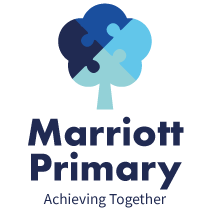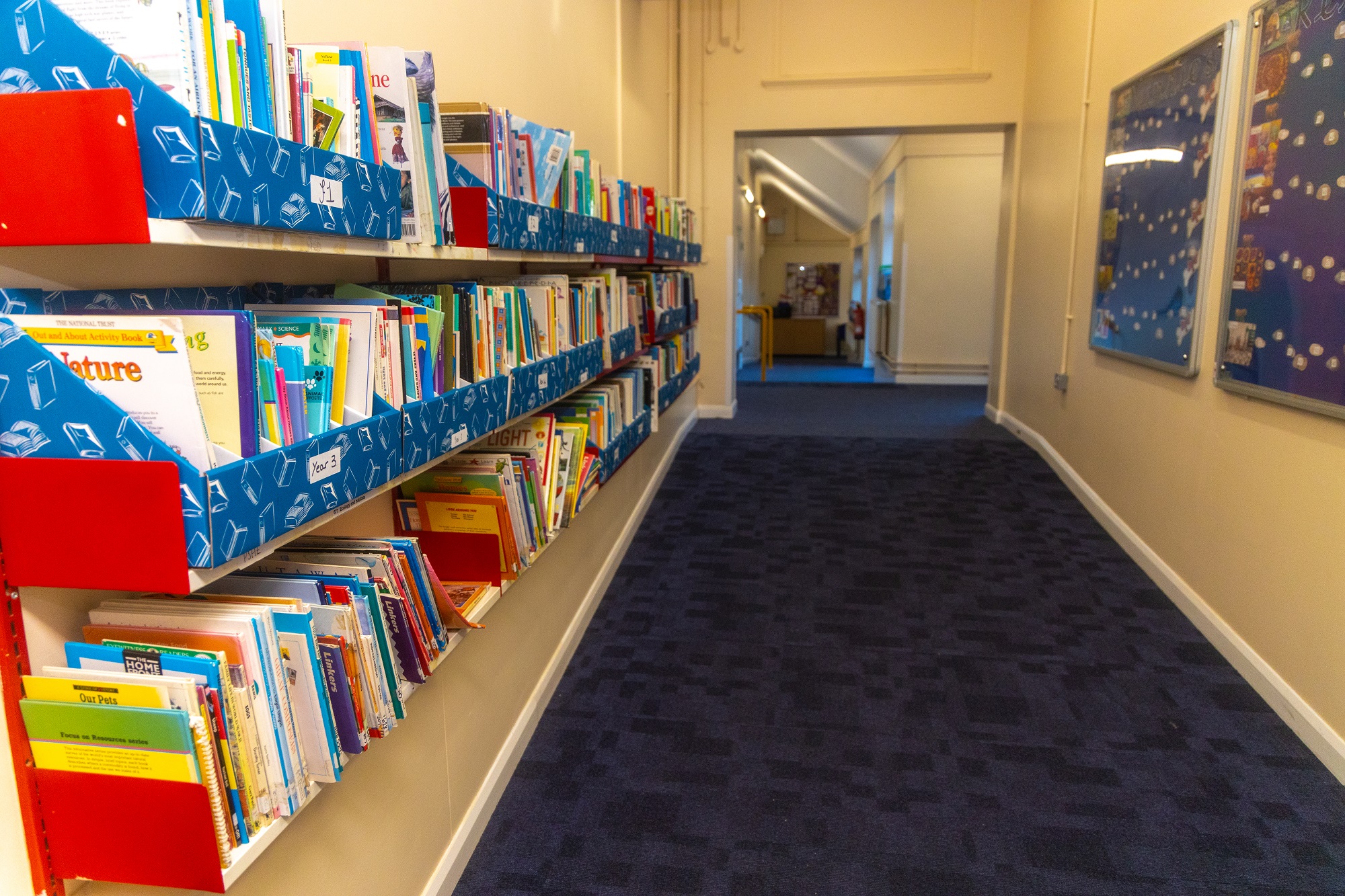Reading at Marriott Primary School
Marriott Primary School aims to foster confident, articulate children who have a love of reading. Linked with the Knowledge Transfer Centre, Foundation Stage and Key Stage One teachers have been trained on teaching shared and guided reading that encourages children to use a range of reading strategies and answer questions about the text. Children in Foundation Stage 1 access stories through continuous provision and when a book is shared and are exposed to reading in their environment. Children in Foundation Stage 2 have guided reading sessions twice a week and regular shared reading sessions.
Children in Year 1 upwards read at least once a week in a guided reading group with an adult where they have the opportunity to read and discuss a book, short story or non-fiction text alongside other children and their teacher.
We use a range of books to meet the needs and interests of all our learners such as Project X, PM readers and in Key Stage Two novels that are linked to our topics. Children work through the levels and colour bands of the reading scheme, moving onto the next level when they are confidently reading around 95% accuracy on a book. Once children are confident and fluent they are exposed to a wide variety of texts and are supported to develop the higher order skills of inference and deduction.
Some children who need support with their reading receive additional support. We are a Reading Recovery School and have trained Better Reading Partners in order to help children make rapid progress in their reading.
All children get to change their home reading books as often as they want and have a home school diary for parents to record every time they listen to their child read. If children read three times a week at home their name gets put into a weekly prize draw to become a reading champion.
Phonics at Marriott Primary School
What is Phonics?
Phonics is a way of teaching children how to read and write. It helps children to hear, identify and use different sounds that distinguish one word from another in the English language.
The Importance of Phonics
Word-reading is one of the essential dimensions of reading; the other is comprehension. Skilled word-reading involves working out the pronunciation of unfamiliar printed words (decoding) and recognising familiar printed words. Underpinning both of these is the understanding that letters represent the sounds in spoken words. Fluent decoding supports pupils’ comprehension, because they don’t have to devote mental energy to individual words. A good grasp of phonics is also important for spelling, contributing to fluency and confidence in writing. (DfE 2012) Phonics is the method of teaching reading and writing by correlating sounds with letters or groups of letters. There are 44 sounds in the English language which we put together to form words. Some sounds are represented by one letter like the ‘t’ in tin, whilst other sounds are represented by two or more letters like ‘ck’ in duck.
Children are taught the sounds, how to match them to letters and finally how to use the letter sounds for reading and spelling.
How do we teach Phonics?
Phonics is a crucial part of Foundation Stage and Key Stage 1 as it gives children the skills to become confident and independent readers and writers. At Marriott Primary School, we follow the Ann L Smallberger (ALS) letters and sounds program to teach Phonics therefore we have daily phonics sessions for Foundation Stage and Key Stage 1 and through this programme we aim to provide a solid and continuous approach to the teaching of systematic synthetic phonics starting from Nursery all the way to Year 2. Children also learn to read and write High Frequency Words (HFW). These are words that don’t rely on phonics and are also organised by the most common words children will read and write. Children at Marriott Primary School are eager to learn new sounds and apply these in their writing. By Reception, children are learning a new sound every day and these are reviewed at the end of the week. We take care to immerse children in phonics by incorporating new sounds with our spellings too.
We ensure that children read texts that are decodable and therefore only meet sounds that they know and can therefore experience success and the pleasure of reading.
There are 5 phases of phonics that the children will work through.
Phase 1 – Phase 1 lies mainly within the areas of communication and language and literacy within the Early Years Foundation Stage. It is the base for all subsequent phonic learning. Children will develop listening skills and phonological awareness in mainly adult-led activities, which will be consolidated and reinforced within the language-rich environment and child-initiated learning. Phase 1 is underpinned by helping children to tune into sounds and discriminate between speech sounds. They will learn to alliterate the initial sound of words and blend and segment words orally.
Phase 2 – Phase 2 phonics teaches the children the phoneme-grapheme correspondence of the first 19 letters. Using these letters, children will learn to blend and segment and will learn to read vc (at, it, up) and cvc (cat, dog, big) words. At Phase 2, children will develop the skill of writing words or making words with magnetic letters/tiles with these initial graphemes. Phase 4 is now introduced in Phase 2 so that children begin to familiarise themselves with adjacent consonant blends. This is also integrated throughout all of the other phases.
Phase 3 – Phase 3 introduces 25 new graphemes, including some long vowels. These graphemes consist of consonant diagraphs (ch, sh, ng), vowel diagraphs (ai, ee, oa) and vowel trigraphs (igh, air, ear). Children will learn to blend these graphemes for reading in one-syllable and two-syllable words. During Phase 3, children will practise writing and making words with consonant digraphs, vowel diagraphs and vowel trigraphs. Children will also learn to read and write captions and sentences with these letters. A rhyming element has also been incorporated into the Phase 3 long vowel lesson plan to ensure that all children can recognise and generate rhyming words by the end of Reception.
Phase 5 – Phase 5 is where children broaden their knowledge of graphemes and phonemes to apply in their reading and writing. They will learn new graphemes for graphemes they already know and will learn alternative pronunciation for some graphemes they have learnt previously. During Phase 5, children will learn to read words with alternative pronunciation of graphemes and words with two and three syllables. Children will learn to choose the appropriate grapheme when writing words and learn to write two-syllable words, three-syllable words and polysyllabic words.
Click on the links below if you would like learn more about reading with your child.
Reading Resources
Useful websites for parents at home
https://www.phonicsplay.co.uk – This is a great website where you will find fun games for children to play online.
https://www.topmarks.co.uk/Search.aspx?q=phonics – A range of phonics games for children to play at different levels
https://home.oxfordowl.co.uk/blog/how-can-i-support-my-child-with-phonics-learning/ – Lots of lovely ideas on how you can support your child with their phonics at home
https://literacytrust.org.uk/early-years/ – Lots of great advice on how to support your child’s phonics journey
https://www.ictgames.com/mobilePage/literacy.html – Phonics games
https://www.education.com/games/word-patterns/ – Phonics games
Phonics Assessment
Every year, in June, the Government publish a National Phonics assessment which takes place. The assessment involves reading a total of 40 words, a combination of real and alien words. Please use the link below to practise this with your child.
https://www.gov.uk/government/publications/phonics-screening-check-2017-materials
Glossary
Blending – To draw individual sounds together to pronounce a word, e.g. /sh/i/p/ blended together reads ship.
Segmenting– Splitting up a word into its individual phonemes in order to spell it., i.e. the word pat has 3 phonemes: /p/a/t/.
Phoneme– The smallest single identifiable sound, e.g. the letters ch representing one sound.
Grapheme– A letter, or combination of letters, that represent a phoneme.
Digraph – A combination of two letters representing one sound, as in ph and sh.
Trigraph – A group of three letters representing one sound, for example ‘igh’
Pseudo words – Words that are not real. These are sometimes called ‘alien words’ or ‘nonsense words’.
How to help your child read at home
Every child needs to be exposed to a range of words and books. Reading at home is extremely important for the development of your child’s language and literacy skills
Starting to learn to read-Things we can do at home
Mum makes sure the television is turned off and spends time helping her son do reading activities. Dad makes reading books an enjoyable time with his son and also hears him read.
Starting to learn to read-Things we can do when we’re out and about
The family use their local library so that their son can enjoy more books. Dad lets his son choose his favourite books and shares good reading habits with him. They find a place in the library where they can talk and enjoy the books they have chosen.
Becoming a more confident reader- Things we can do at home
Sending and receiving letters provides a great opportunity for reading and writing. Mum breaks down difficult words to help her daughter read them. Mum and daughter spend special times together enjoying books without being distracted.
Becoming a more confident reader- Things we can do when we’re out and about
Mum uses cooking together as an enjoyable activity to share reading for a purpose. Mum gives her daughter lots of simple reading tasks when they are out shopping together. Mum is always helping her daughter to learn new words without making it a test.

